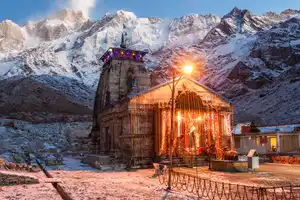Kedarnath Dham Month-Wise Weather Conditions
Home » Kedarnath Dham »
 Located at an elevation of 3,583 metres above sea level by the holy River Mandakini, Kedarnath Dham is situated on the lap of the Garhwal Himalayan range. This temple is also one of the most prime 12 Jyotirlingas in India and is also a part of the holy Chota Chardham Yatra of Uttarakhand. As per legend, this temple was established by the Pandava brothers when they visited this site to ask for forgiveness from Lord Shiva after the Mahabharata war, for killing their kin (Kauravas, their cousins). Set against the majestic backdrop of the mighty Nar Narayan Mountains the route to Kedarnath goes through the scenic and breathtaking valley.
Located at an elevation of 3,583 metres above sea level by the holy River Mandakini, Kedarnath Dham is situated on the lap of the Garhwal Himalayan range. This temple is also one of the most prime 12 Jyotirlingas in India and is also a part of the holy Chota Chardham Yatra of Uttarakhand. As per legend, this temple was established by the Pandava brothers when they visited this site to ask for forgiveness from Lord Shiva after the Mahabharata war, for killing their kin (Kauravas, their cousins). Set against the majestic backdrop of the mighty Nar Narayan Mountains the route to Kedarnath goes through the scenic and breathtaking valley.
Due to the extreme elevation, the temperature here remains extremely cold and chilled throughout the day. During summer months when the doors of the temple are opened for darshan then the entire route is cleared for the pilgrims and devotees who take up this journey. When the doors close for darshan during the winter months the path leading up to the temple gets buried in white stark snow making the temple inaccessible and impossible to visit. During this time devotees can visit the winter seat of Lord Shiva which is located at Ukhimath in Rudraprayag district.
If you are planning a Chardham Yatra trip or just a spiritual trekking journey then you should know which the best season for you to go exploring. Here is a detailed and comprehensive month – wise division of weather conditions in Kedarnath:
January: January is the coldest month in Kedarnath. During this time the town experiences heavy snowfall. The roads and trekking paths are completely covered in stark white snow and any sort of pilgrimage journey is halted for the entire season. The temperature dips to as low as -12 degrees Celsius.
February: The overall temperature of the area remains extremely cold and chilled with the temperature going as low as -8 degrees Celsius. Yatra, pilgrimage and outdoor adventure sports activities are also halted for the season.
March: The weather during this month also remains extremely chilled and cold with the land still being engulfed in a thick blanket of snow. However, the temperature becomes a little more bare-able with the maximum being 5 degrees Celsius.
April: This month the entire area is still cold and little more comfortable than the month of January. The peak temperature here touches 7 degrees Celsius and the minimum can dip till 2 degrees Celsius. Usually, the yatra commences by the end of this month or by the beginning of the following month.
May: This is considered to be one of the best months to visit Kedarnath since not only are the doors of the temples thrown open for darshan but the temperatures also enter a comfortable zone. This also marks the beginning of the summer months with the temperature going till 10 degrees Celsius.
June: This is also one of the most preferred and the best season to go on a Kedarnath yatra when the roads are cleared. Pilgrimage flock this main temple shrine during this season with the temperature ranging between 15 degrees Celsius to 5 degrees Celsius.
July: This summer month witnesses the commencement of the monsoon and rainy season making the temperature dip. During this time the peak temperature rises till 16 degrees Celsius and dips till 10 degrees Celsius.
August: Pilgrimage and yatra during this season is highly discouraged since the rainy season since the entire area remains prone to heavy mudslides and landslides making it extremely unsafe. The temperature falls between 15 degrees Celsius and 8 degrees Celsius.
September: This temperature also remains the same as the last two seasons with the climate being cold, chilly and prone to natural avalanches and landslides. The temperature ranges between 14 degrees Celsius to 5 degrees Celsius.
October: This month marks the starting of the cold winter season. The temperature ranges between 12 degrees Celsius to 1 degree Celsius. This can also be one of the most preferred seasons for a winter trek journey. The temple shuts off for darshan during end of this month depending on the date for bhai dooj. The temperature falls between 12 degrees Celsius to 1 degree Celsius.
November: The main temple closes down for the season during the beginning of this month (depending on the date of Bhai Dooj) and the entire region gets shut down and covered completely in snow. During this time the temperature falls till -2 degrees Celsius.
December: Winter is in its full blow during this month with the temperature dipping till -8 degree Celsius. Snowfalls are a regular occurring during this month making it impossible to Visit Kedarnath Dham.
This was a comprehensive and informative guide to Kedarnath Dham which is aimed at helping you have a fulfilling journey. We hope you find this month wise guide to Kedarnath a helping hand in your endeavours towards attaining spirituality.


Leave a Reply